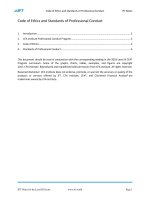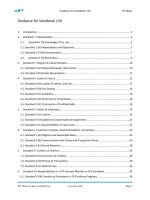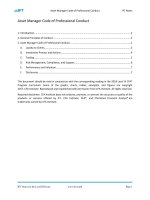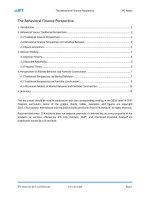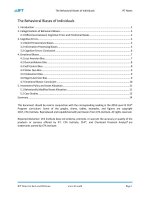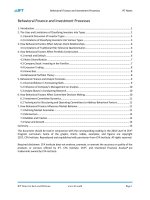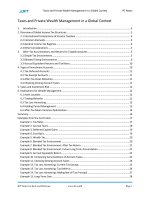CFA 2018 level 3 schweser practice exam CFA 2018 level 3 question bank CFA 2018 r07 behavioral finance and investment processes summary
Bạn đang xem bản rút gọn của tài liệu. Xem và tải ngay bản đầy đủ của tài liệu tại đây (579.06 KB, 9 trang )
Level III
Behavioral Finance and Investment Processes
Summary
Graphs, charts, tables, examples, and figures are copyright 2014, CFA Institute.
Reproduced and republished with permission from CFA Institute. All rights reserved.
Uses and Limitations of Classifying Investors into Types
Investors can be classified by their psychographic profile i.e. behavior, personality, attitudes and interests.
BB&K (Bailard, Biehl and Kieser) model classifies investors into five types based on two axes of “investor psychology”.
Hint: selfemployed
Confident
Individualist
• make decisions after careful analysis
• listen to advice
• process information in a rational
manner
• high risk tolerance
• prefer to maintain control over
investments
• reluctant to take advice
• hold highly undiversified portfolios
Straight
Arrow
Careful
Guardian
Hint: Retired
or near to
retire people
Adventurer
• prefer to seek advice
• avoid volatility
• seek preservation of wealth
Impetuous
Celebrity
• prefer following popular investments
• willing to take investment advice
rational, balanced,
secure and sensible
Anxious
www.ift.world
2
Behavioral Alpha Process
A top-down approach to bias-identification
1. Interview client to identify active or passive traits
and risk tolerance
2. Plot investor on active/passive scale and risk
tolerance scale
Active investors: medium to high risk
Passive investors: low risk
•
•
•
•
•
•
•
3. Test for behavioral biases to identify behavioral
biases in a client
Active Investor Traits
Earned wealth by risking own money (e.g.
entrepreneur)
Maintain control over investment decisions
Have faith in own abilities
Prefer risky asset allocation
Aim for maximization of wealth by foregoing
current lifestyle
Take initiative
Not reluctant to borrow money
Opposite will be true for passive investor
4. Classify investor into a behavioral investment type
(BIT) to identify biases
If an investor is classified as active investor in Step 1
but he exhibits low risk tolerance in Step 2, then
assume he/she is a passive investor.
www.ift.world
3
Behavioral Investor Type Diagnostic Process
How Behavioral Factors Affect Client-Adviser Relations
Understanding client’s behavioral tendencies allows
advisors to:
• better formulate financial goals.
• better understand the client before delivering any
investment advice.
• formulate an appropriate asset allocation for the
client.
• develop a stronger bond by satisfying clients.
Limitations of Classifying Investors
An individual may:
• exhibit both cognitive and emotional biases at the
same time.
• reflect characteristics of multiple investor types.
• exhibit changing behavior over time.
• need unique treatment.
• act irrationally and in an unpredictable manner.
www.ift.world
4
Biases Associated with Each Behavioral Investor Type (BIT)
Basic type
Passive
Passive
Active
Active
Low
Low to medium
Medium to high
High
Conservative
Moderate
Growth
Aggressive
Emotional
Cognitive
Cognitive
Emotional
BIT
Passive Preserver
• dislike losses
• dislike change
• uneasy during times of stress
• probably became wealthy
passively (through inheritance)
• under-react to new
information
Friendly Follower
• follow others
• invest in popular investments
• believe that their forecasts about
future events were more
accurate than they actually were
• respond differently based how
questions are framed
• overestimate risk tolerance
Independent Individualist
• overestimate ability to predict
• maintain views on market
• under-react to new information
• do not get corroboration from other
sources
• place higher weight to information which is
readily available
• make decisions based on personal
classification
Emotional
biases
•
•
•
•
• regret aversion
• overconfidence & self-attribution
Cognitive
biases
• mental accounting
• anchoring and adjustment
• availability
• hindsight
• framing
•
•
•
•
Investment
advice
• difficult to advise
• explain effects of investment
decisions on various
investment goals
• may listen to advice
• advisors should provide
quantitative measures
• may listen to advice
• advisors should provide quantitative
measures
Risk tolerance
Investment style
Primary bias
loss aversion
status-quo
endowment
regret aversion
www.ift.world
conservatism
confirmation
availability
representativeness
Active Accumulator
• entrepreneurial
• exhibit over-confidence in
their ability to predict or
succeed
• do not save for future
• actively involved in
decision-making trade
excessively
• overconfidence
• self-control
• illusion of control
• most difficult to advise
• explain effects of
investment decisions on
various investment goals
5
Impact of Behavioral Factors on Portfolio Construction
Behavioral Factors/Biases
Impact on Portfolio Construction
Status quo bias
Sticking with default portfolio allocation despite changes in
risk tolerance level or other circumstances.
Regret aversion and framing biases
Naïve diversification or 1/n strategy: allocating an equal
amount of money to available investment options regardless
of the different risk profiles of these options.
Overconfidence, representativeness
& availability, status-quo, framing,
endowment biases
Investing in the familiar: a classic example is being
overweight in own-company stock.
Regret aversion, overconfidence, and
disposition effect (loss aversion)
biases
Excessive trading which results in high transaction costs and
poor portfolio performance.
Availability, illusion of control,
endowment, familiarity, and status
quo biases
Investors invest a relatively high portion of their funds in
domestic stocks. Home bias.
www.ift.world
6
Impact of Behavioral Factors on Analysts
Behavioral Factors Biases
Remedial Actions
Overconfidence in
forecasting skills
Overconfidence (encouraged by complex
models), representativeness, availability,
hindsight
Prompt and accurate
feedback, structure that
rewards accuracy, learn to use
Bayes’ formula
Influence of
company’s
management on
analysis
Faming, anchoring and adjustment (analysis
Disciplined and systematic
influenced by initial default position or anchor), approach
availability (greater importance to more easily
available information)
Analyst biases in
conducting
research
Excessive unstructured information illusion
of knowledge overconfidence
Excessive information feeds representativeness
bias (classify new information based on past
experiences)
Confirmation bias
www.ift.world
Focus on objective data,
systematic and structured
approach, follow Standard V,
seek contrary facts and
opinions
7
Behavioral Factors and Investment Committees
Social proof bias: Following the view points/decisions of a group.
Implications:
• Group members become overconfident among themselves leading to excessive risk exposure.
• Group decisions are more vulnerable to confirmation bias.
• Group member avoids divergent opinions to avoid unpleasant tensions within a group.
Remedial Actions
• Individual views should be collected before the meeting.
• Committee composition should have diversity in culture, knowledge, skills, experience and
thought processes.
• Chair of the committee should be impartial.
• Committee members should respect opinions of each other.
• At least one member of a group should play a role of “devil’s advocate”.
www.ift.world
8
Investor Behavior and Markets
Observed Market Behavior Behavioral Explanation
Momentum or trending
effect
Herding behavior
Availability bias: more recent events easily recalled and given relatively
high weight (recency effect)
Hindsight bias regret trend-chasing effect
Bubbles
Overconfidence bias (illusion of knowledge and self attribution) leads
to underestimation of risk and over-trading
Crashes
Disposition effect in the context of loss aversion bias: tendency to sell
winners quickly and hold on to losers too long
Value stocks outperform
growth stocks in the longrun
Halo effect: tendency of people to generalize positive views/beliefs
about one characteristic of a product/person to another characteristic;
related to representativeness bias refers to classifying new information
based on past experiences
www.ift.world
9

